Podcast: Play in new window | Download
In today’s episode (76) of my podcast, I want to answer a question I received several times – Should you mix multiple watercolor paint brands?
The Importance of Watercolor Brands
The question at hand may be tactical, but my answer is also an indication of my general approach to painting and art.
I always try focusing on the 20% that matters. I do that in my art, business and hopefully in life.
There’s always a lot of noise and clutter around what’s really important.
Watercolor painting is already complex as it is – so I’m always trying to simplify the process as much as possible. This is also why I’m a huge fan of using a minimal palette.
Paint > Brand
The quick answer is that I care FAR MORE about the specific paint and its usefulness to me, rather than the brand.
I personally find most (ARTIST GRADE) paints mix well, regardless of brand.
There are certain things you want to be aware of (that I further elaborate on in the episode), such as:
- Producing a large variety of values
- Artist grade VS student grade
- Single pigment / multiple pigments
- Granulation
- Lightfastness
I hope you find the explanation in the episode helpful, and that it allows you to change your focus from specific brands and into specific paints.
And by the way, if you want to watch the video from which I grabbed the audio for this episode, be sure to check it out here:
And with that, it is time for the Artist Corner
Artist Corner – Jennifer Branch
Today I showcase Jennifer Branch, a watercolor painter from Georgia, US.
I love her simplistic impressionistic painting style, as well as focus on happy colors.She has a way of simplifying a scene in a skilled way that preserves its original essence.
Some of her work reminds me of Shari Blaukopf’s work, although the latter’s work has more of an “urban sketching” vibe to it.
Be sure to check out Jennifer’s work here: Jennifer Branch’s Website
And Here’s where you can find me
Check out my YouTube Channel – Liron Yanconsky
Or ask me questions on Instagram – @LironYanIL or Snapchat – @LironYan3
I hope you enjoyed this one. Take care, and we’ll talk again really soon,
— Liron









